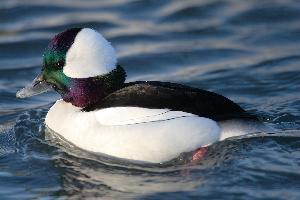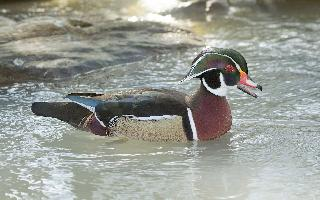
Állatleírás
The Barnacle Goose (Branta leucopsis) is a captivating bird species that belongs to the family Anatidae, which includes ducks, geese, and swans. This medium-sized, striking bird is known for its distinctive appearance and remarkable migratory behavior. It has garnered attention from birdwatchers and conservationists alike for its unique characteristics and the challenges it faces in the wild.Physical Description:
The Barnacle Goose is characterized by its beautiful black and white plumage, which gives it a distinguished look among geese. Adults typically have a black head, neck, and upper breast, with a striking white face that extends from the forehead down to the throat. The back is primarily grey, with finely barred black and white feathers giving it a scalloped appearance. The belly is white, providing a stark contrast to the darker colors of its upper body. Its bill is black, short, and robust, ideal for grazing, while its legs and webbed feet are also black. This species exhibits little sexual dimorphism, meaning males and females look similar, though males are generally slightly larger.
Size and Weight:
Barnacle Geese are relatively small for geese, with a body length ranging from 55 to 70 centimeters (22 to 28 inches), a wingspan of 130 to 145 centimeters (51 to 57 inches), and a weight varying between 1.2 to 2.2 kilograms (2.6 to 4.9 pounds). Their size and build facilitate long-distance flights, especially during their migratory seasons.
Habitat and Distribution:
Barnacle Geese breed in the Arctic regions of the North Atlantic. Their breeding grounds are mainly found in Greenland, Svalbard, and the Russian Arctic. In winter, they migrate to more temperate areas, with major wintering grounds located in the British Isles, particularly in Scotland and Ireland, and along the North Sea coasts of Germany and the Netherlands. They prefer habitats such as Arctic tundras, coastal marshes, estuaries, and agricultural fields during migration and wintering.
Behavior and Diet:
Barnacle Geese are primarily herbivorous, feeding on grasses, aquatic plants, and crops. During the breeding season, they also consume mosses, berries, and small invertebrates to supplement their diet. They are highly sociable birds, often seen in large flocks, especially during migration and in their wintering grounds. Their vocalizations are a series of loud, barking calls, which are frequently heard during flight and social interactions.
Reproduction:
The breeding season begins in late May or early June, when pairs return to their Arctic breeding grounds. Barnacle Geese are monogamous, with pairs often remaining together for several years. Nests are usually located on cliff ledges, islands, or other sites with minimal predator access. Females lay 3 to 5 eggs, which are incubated for about 24 to 25 days. The young are precocial, able to leave the nest and feed themselves shortly after hatching, though they remain under the protection of their parents.
Conservation Status:
The Barnacle Goose is currently classified as Least Concern by the International Union for Conservation of Nature (IUCN), thanks to conservation efforts and protected habitats that have helped stabilize and even increase some populations. However, they still face threats from habitat loss, climate change, and hunting in certain areas.
In summary, the Barnacle Goose is a fascinating and resilient species with a distinctive appearance and intriguing life history. Its ability to thrive in harsh Arctic conditions, along with its successful adaptation to changing environments, makes it a remarkable example of avian endurance and adaptability.
Hasonló állatok
Új állatfotók
Top 10 állat
- Dolphin gull (Leucophaeus scoresbii)
- Diana monkey (Cercopithecus diana)
- Moustached guenon (Cercopithecus cephus)
- Galápagos tortoise (Geochelone nigra complex)
- Japanese macaque (Macaca fuscata)
- Stone loach (Barbatula barbatula)
- Russian tortoise (Testudo horsfieldii)
- Greek tortoise (Testudo graeca)
- Common flying dragon (Draco volans)
- Vendace (Coregonus albula)


